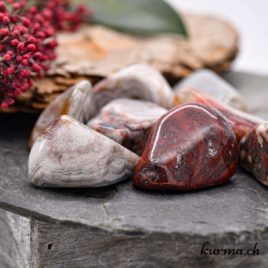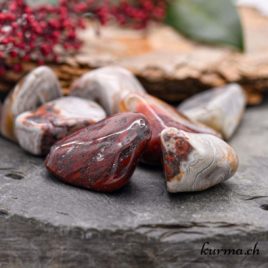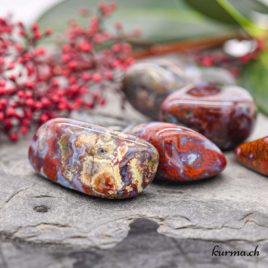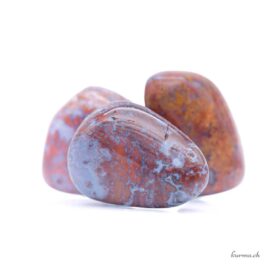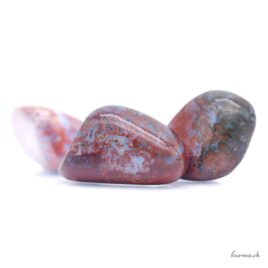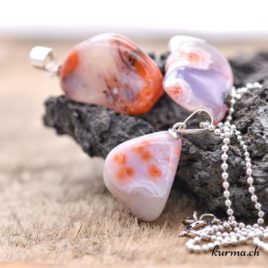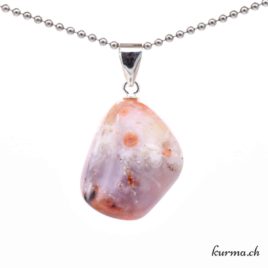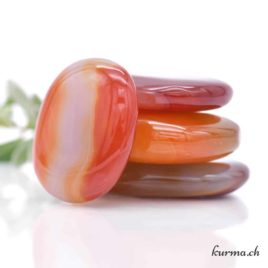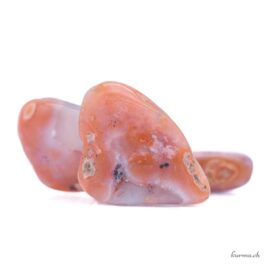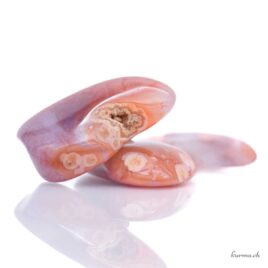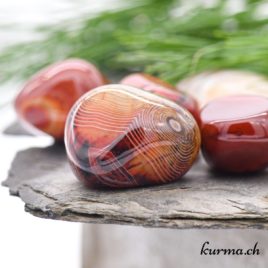Red Agate
gemstones, natural, pendants, rolled stones, pebbles, Crazy Lace, Moroccan, moss, ribboned
A stone of stable vitality in lithotherapy,red agate is a variety of chalcedony with dark or light, but always intense hues.
Stone pendants Agate Pendant
Pebbles for lithotherapy Stones and minerals from A to Z Agate Agate crazy lace Moss agate Red moss agate Red agate
Rolled stones for lithotherapy Rolled moss agate Rolled agate
Stainless steel Acrylic Silver Wood Bronze Kraft cardboard Ceramics Cotton Leather Copper Dimensions : Elastic Epoxy Iron Jute Brass Silver Brass Golden Brass Metal Mother-of-pearl Nylon Waxed nylon Organza Orgonite Bones Pierre Plastic Polyester Pink quartz Resin Rudraksha Satin Salt Leatherette Silk Suede lining Terracotta Title Dimension Velvet Glass
7 chakras Abalone Adamite Aegirine Agate Apricot agate Tree agate White agate Agate Carnelian Agate Crasy Lace Agate Crazy Lace Water agate Fire agate Dendritic agate Botswana Agate Agate flower Agate geode Agate grappe Moss agate Pink moss agate Orbicular agate Snakeskin agate Red agate Agate turitelle Zebra agate Aquamarine Albite Alexandrite Amazonite Amber Amethyst Rough amethyst Heated amethyst Druze amethyst Ametrine Ammonite Ancestralite Andalusite Andradite Angelite Anhydrite Anthophyllite Antimony Apatite Blue apatite Green apatite Aplite Apophyllite Aragonite Blue aragonite Slate Astrophyllite Atlantasite Augite Auralite Aurichalcite Aventurine Blue aventurine Aventurine orange Red aventurine Green aventurine Azul Bahia Azurite Azurite Malachite Baryte Barite Basalt Beryl Biotite Bismuth Blende Petrified wood Bornite Brazilianite Bronzite Yellow brucite Bryozoaire Buddstone Cacoxenite Chalcedony Blue chalcedony Chalcedony ocean Green chalcedony Green chalcedony Calcite Apricot calcite White calcite Blue calcite Yellow calcite Optical calcite Orange calcite Pink calcite Red calcite Green calcite Cavansite Célestine Chalcopyrite Coal Charoïte Lime Chiastolite Chrysoberyl Chrysocolla Chrysopale Chrysoprase Chrysotile Cinnabar Cintamani Citrine Cobaltocalcite Copal Coprolite Corail Fossilized coral Corundum Carnelian Covelline Covellite Fossil crinoids Rock crystal Copper Cuprite Cyanite Danburite Shark tooth Diaspore Diopside Dioptase Orbicular diorite Disthène Dolomite Dravite Dumortierite Eclogite Eilat stone Eldarite Kambaba Emerald Enstatite Epidote Eudialyte Feldspar Fluorite Rainbow Fluorite Blue fluorite Brown fluorite Yellow fluorite Lavender fluorite Green fluorite Violet fluorite Franklinite Fuchsite Fulgurite Gabbro Galaxite Galena Gedrite Gem Silica Agate geode Goethite Goshenite Granite Graphite Garnet Coarse garnet Hessonite garnet Pyrope garnet - Almandin Rhodolite garnet Tsavorite garnet Sandstone Gypsum Halite Heliodore Heliotrope Hematite Hemimorphite Herkimer Heulandite Hiddenite Hilutitis Hornblende Howlite Hyacinthe Hypersthene Iolite Jade African jade Burmese jade Chinese jade Canadian Jade Nephrite jade Black jade Jadeite Jadeite lavender Green jadeite Jais Jasper Red rainbow jasper Rainbow Jasper Bumblebee jasper Breccia jasper Chalcedony Jasper Dalmatian jasper Fossil jasper Yellow Jasper Jasper K2 Kambaba Jasper Leopard jasper Mookaïte Jasper Landscape jasper Picasso Jasper Polychrome jasper Red jasper Dragon's blood jasper Snake jasper Turitelle jasper Zebra jasper Kimberlite Kunzite Labradorite White Labradorite Lapis lazuli Larimar Larvikite Washing machine Lazulite Leopardite Lepidocrocite Lepidolite Lizardite Luxullianite Fossil Mabre Magnesite Magnetite Malachite Manganocalcite Marble Fossil marble Marcasite Mariposite Menalitis Merlinite Meteorite Mica Moldavite Mookaïte Morganite Muscovite Mother-of-pearl Nellite Nephritis Nickéline Nunderite Nuummite Obsidian Mahogany obsidian Rainbow obsidian Silver obsidian Golden obsidian Obsidian snowflake Obsidian lamella Obsidian Apache tear Huichol Manta obsidian Black obsidian Obsidian celestial eye Tiger eye Oeil-de-boeuf Hawkeye Horseshoe Tiger's eye Oncolite Oncolith Onyx Black onyx Green onyx Oolite Opale White opal Boulder opal Opale cappuccino Fire opal Dendritic opal Andes Opal Honduran opal Yellow opal Moss opal Black opal Pink opal Green opal Opaline Orthoceras Orthose Fossilized dinosaur bone Pargasite Peridot Petalite Phosphosiderite Piemontite Bluestones of Stonehenge Moonstone White moonstone Grey moonstone Black moonstone Peach moonstone Fairy Stone Sunstone Pietersite Pinolite Plagioclase Porphyry Prasem Prasiolite Prehnite Psilomelane Purpurite Pyrite Pyrophyllite Quartz Quartz - Limonite Core quartz or Faden Quartz actinolite White quartz Blue quartz Shaman quartz Lemon quartz River quartz Dendritic quartz Ghost quartz Strawberry quartz Smoky quartz Girasol quartz Grey quartz Hematoid quartz Lavender quartz Quartz lodolite Quartz Morion Snow quartz Cat's-eye quartz Peach quartz Quartz prase Pink quartz Rutile quartz Solar quartz Sulfurous quartz Tourmaline quartz Green quartz Rhodochrosite Rhodonite Rhyolite Rhyolite leopard Rhyolite liesegang Green rhyolite Golden river Rosasite Rose des sables Rubellite Ruby Ruby Fuchsite Zoïsite ruby Sapphire Blue sapphire Yellow sapphire Sardonyx Scapolite Scolecite Salt Selenite Septaria Seraphinite Serpentine Serpentine Chyta Serpentine Clinochlore Shattuckite Shiva Lingam Shungite Siberite Siderite Flint Silicon Smaragdite Smaragdite Allalin Gabbro Smithsonite Sodalite Spectacularity Spectrolite Sphalerite Sphene Spiderweb stone Spinelle Spodumene Staurolite Soapstone Stibine Stichtite Stilbite Stromatolite Sugilite Super Seven Syenitis Tanzanite Tectite Tectite cintamani Tenorite Thulite Tiffany stone Titanite Topaz Blue topaz Imperial topaz Yellow topaz Tourmaline Blue tourmaline Brown tourmaline Watermelon tourmaline Multicolored tourmaline Multicolored tourmaline Black tourmaline Pink tourmaline Green tourmaline Violet tourmaline Travertine Triplite Turquoise Turquoise (synth) Unakite Uvarovite Vanadinite Variscitis Verdelite Verdite Libyan glass Vesuvianite Vivianite Vulcanite Wagnerite Wollastonite Wulfenite Wurtzite Yooperlite Zincite Zircon Zoïsite
Stone with clasp Pierced stone
Brilliant Gross Diamanté Mate Polished
Argus Atlantis Builder Stick Ball Gross Gross rounded Crude in pieces Bullet with tank Square Mushroom Heart Cone Conical Crystallized Cube Cylinder Décagone Disc Dodecahedron Dome Radiance Egyptian Tetrahedral star Veneer Leaf Fleur Roller Drop Hexagon Isis Kito Lingam mesh2 Merkaba Nuggets Octahedron Octagon Osiris Oval Palm Rolled stone Point Polis Pyramid Round Washer Roulée Sephoroton Sphere Elongated sphere Spiral Indicator Tetrahedron Twisted Triangle Venus
With facets Without facets
No_Code_size_crfp Powder XXXS XXXXL XXXXXL XXXL XXL XL L M S XS XXS Mini
S-M M-L One size Batch 0.2mm 0.25mm 0.3mm 0.35mm 0.38mm 0.4mm 0.45mm 0.46mm 0.5mm 0.6mm 0.61mm 0.7mm 0.75mm 0.76mm 0.8mm 0.91mm 1mm 1.6cm 2cm 3cm 3.5mm 3.7mm 4mm 4cm 4.5mm 5x5cm 5mm 5cm 5.5mm 6cm 6mm 6.5mm 7cm 7mm 7x9cm 7x8cm 7.5mm 8cm 8mm 8-9cm 8x10cm 8x8cm 8.5mm 9cm 9mm 9-10cm 9.5mm 10x10cm 10x14cm 10-12cm 10cm 10x11cm 10mm 10-11cm 10.5mm 11cm 11mm 11.5mm 12x15cm 12mm 12-15cm 12cm 12-13cm 12x17cm 13mm 13cm 14x20cm 14mm 14cm 15-16cm 15mm 15cm 15x12cm 16mm 16-19 16cm 16-17 16.5mm 17-18mm 17mm 17cm 17.5 17.5mm 18cm 18mm 19cm 19mm 19x13cm 19.5mm 20x30cm 20mm 20cm 21cm 21mm 22cm 22mm 23mm 24mm 25mm 25cm 26mm 28mm 29mm 30mm 30cm 32cm 32-33cm 34cm 35mm 36cm 38mm 38cm 40cm 40mm 42cm 43-44cm 45mm 46cm 50mm 50-52cm 53cm 54cm 57cm 60mm 60-62cm 70mm 70cm 90mm
0.4mm 0.5mm 0.6mm 0.7mm 1mm 1.5mm 2mm 2.3mm 2.4mm 2.5mm 2.6mm 2.8mm 3x2mm 3mm 3.4mm 3.5mm 3.8mm 4x3mm 4mm 4.2mm 4.5nn 4.5cm 4.5mm 5mm 5x8mm 5x7mm 5-10mm 5.5mm 5.5cm 6mm 6x8mm 6x10mm 6x4mm 6-7mm 6.5mm 7mm 7.5mm 8mm 8x6mm 8.5mm 9mm 9.5mm 10x6mm 10x15mm 10x12mm 10mm 10.5mm 11mm 11.5mm 12mm 12.5mm 13mm 13.5mm 14mm 14.5mm 15mm 15.5mm 16mm 16.5mm 17mm 18mm 19mm 20mm 21mm 22mm 25mm 35mm
Chain 36cm Chain 38cm 40cm chain 42cm chain Chain 44cm 45cm chain Chain 46cm Chain 48cm 50cm chain 55cm chain Chain 60cm 66cm chain 70cm chain 75cm chain 80cm chain 90cm chain
Photo non contractuelle Unique piece
Silver 925 Silver 925 gilt 925 silver with patina Polished 925 silver 925 silver, rhodium-plated
1mm 1.5mm 1.6mm 1.8mm 2mm 2.2mm 2.4mm 2.7mm
Closed Open
Mark of responsibility Stamp
Aromafume Ayurvedic Stick Bohemia Fiore d'Oriente Fleur de Vie Fragrances andamp; Sens Gangchen Himalayan Golden Goloka Green Tree HEM Herb andamp; Earth Ispalla Kriti Mainichiko Viva Mandala Art andamp; Incense Mani Bhadra Marco Polo's Treasures Maroma Morning star Nippon Kodo Armenian paper Perma Nature Sagrada Madre Satya Terra Tribal Soul Yogi andamp; Yogini Naturals
Stick Brick Cone Backflow cone Cord Dhoop Fagot Palo Santo Paper Bulk plant Powder Resin and gum Smudge ball Stem Torch Braid
Amber Anise Wormwood Arruda Assa Foetida With herbs Goji berry Balsamic Basil Benjoin White Benzoin Benjoin de Siam Bergamot Black Champa Aloe Wood Cedar wood Sandalwood Agarwood Breu Calendula Chamomile Camphor Cinnamon Cardamom Carob Cedar Champa Chandan Honeysuckle Beeswax Coconut wax Lemon Lime Lemongrass Clove Cucumber Copal White Copal Coriander Dammar Incense Spruce Eucalyptus Fleur de Paille Flowers Sweetgrass Frankincense Freesia Gardenia Juniper Geranium Ginger Goja Gum Arabic Guar gum Gum Damar Exotic Herbs Hibiscus Jasmine Kasturi Tears from Somalia Laurel Lavender Wild lavender Lemon Grass Magnolias Mandarin Manna Chios putty Matcha Mint Peppermint Honey Mila Phoenician mullein Musk Arabian Musk White Musk Nutmeg Myrrh Black Myrrh Red myrrh Nag Champa Naga Nard (Pang Poe) Neem Nepal Darshan Neroli Nutmeg Olibanum White frankincense Opium Opoponax Orange Orchid Oudh Palo Santo Grapefruit Patchouli Pine Peony Gokul resin (Bdellium) Rosemary Rose Rose of Jericho Rosehip Roses Rue Safran Sandalwood Sandaraque Dragon's blood Sandalwood Fir Sage White sage Blue sage Desert sage Black sage Royal Sage Green sage Seiun Shasta Styrax White tea Rose tea Green tea Thyme Tokusen Sagano Tokusen Shibayama Tulsi Valerian Vanilla Verbena Vetiver Violette Yagra White Yagra Yerba mate Yerba Santa Ylang ylang Zuiun
1001 nights 3 Wise Men 5 Tibetan rituals 7 Herbs 7-day energy cleansing 7 days of renewal 7 powers Aastha Air Ajna Amitaba Buddha Love Anahata Anti-stress Tree of Life Archangels Armenia Aura Ayurvedic Divine Blessing Bethlehem Black Forest Hello Buddha Medicine Buddha Ball Calm Celtic Chakra Chenrezig Chill-out Clear Mind Set Communication Spiritual connections Sunset Healing Crystals Darshan Unlock Divine Doctor's Advise Dosha Sweet dreams Dragon Blood Dream Sage Water Tibetan incense Energizing Emotional balance Indian Summer Ether Everest Fantasy Feng shui Light Dragon Fire Fleur de Vie Foundation For You Force of will Forest Dew Forest Fortune Sacred Smoke Ganesh Good Earth Good Karma Graine de Vie Healing Harmonie Healing Health is Wealth Heaven Himalaya Hit Holy Temple Into the Night Intuition and clarity Sacred Garden Jerusalem Jesus of Nazareth Joy and love Jupiter Kailash Kalachakra Karma KuruKulla Kyra Sacred Lama Long life Lotus Lumbini Magic Lavender Maha Masala Blended Mahakala Mandala Manipura Manjushri Mantra March Meditation Menche Mercure Midnight Mila Milarepa Mokchhya Morning Time Muladhara Mystery Nag champa Nag Darshan Nag Forest Nag Himalaya Nag Mantra Nag Meditation Nag Oliban Nag Temple Namaste Natural Fresh Nature Nepal Darshan Neptune Nest Energy Cleansing Night Queen Nirvana Notre Dame de Lourdes Ocean Om Shanti Orchid Karma Oriental Pearl Padmasambhava Paljor Healing Armenian paper Father Pio Mindfulness Pontifical Positive Vibes Prana Prosperity Protection Provence Purity Purification Pyramids Refill Regenerating Reiki Relaxation Reborn Revitalize Sacred Ritual Moon rituals Rose Mystique Royal Sandal Sacred Heart of Jesus Sacred Heart of Mary Sahasrara Saint Ange Gardien Saint Anthony of Padua Saint Benoit Saint Gabriel Archangel Saint Joseph Saint Raphael Archangel Sainte Rita Sainte Thérèse Sama Khapha Sama Vata Shambala Snowlion Sun Spa Spiritual Guide Spiritual Healing Sunrise Super Hit Swadhistana Sweet Dreams Oriental Tantra Tara Taro Tashiri ritual Temple Sacred Temple Earth Mother Earth Tibetan Bouddhist Tradition Uplifting Uranus Veda Everlasting Veda Swar Champak Veda Usha Ginger Lily Venus Black Virgin Vishudda Yin Yang Yoga Zambala Zen Meditation
Cedar Lemon grass White sage
Breakages Chips Pieces Powder
100gr 100pcs 10gr 10pcs 1kg 1pcs 200gr 20gr 500gr 50gr 5pcs
Buddha Ganesh Tara
Lithotherapy card Book Oracle
Adama Sesay Adriana Ayales Alberto Villoldo Alexandra Celerault Alida Noordegraaf Amalia Iuliana CHITULESCU Amanda WILD Amy Blackthorn Ana Victoria Calderon Anaïs Carmen Bourquin Angela Hartfield Angelique Guehl Archie Fire Lame Deer Arnaud Riou Aurélia Mariani Aurore Jossevel Aurore Widmer Carla Cartagena Carla Lee Morrow Carlos Fama Caroline Manière Caroline Robin Catherine Darbord Catherine Maillard Célia Melesville Chanceland Charlotte Daynes Chatriya Hemharnvibul Chloé Cres Chris Verbeke Christelle ARONDEAU Christina Dehoff Christine Arana Fader Claire Duval Claudette Jacques Claudia Olivos Clémentine Rocheron Cléophée Clothaire Guérin Colette Baron-Reid Colin Murray Coralie MONPONTET Cyril Steffan Damien Jacquemet Danielle Noel Daphna SEBBANE Debbie MALONE Deepak Chopra Denise Linn Devin Edmond Diana Cooper Dominique Coquelle Don Ernesto ORTIZ Doreen Virtue Dr. Wighard Strehlow Dylan Collin Elizabeth Tiethoff Elodie LECLERCQ Elsa Khapatnukovski Emily Nicolle Esteban Frederic Eve Korrigan Fanaha Fournier Josiane Gabriel Sanchez Gemma Summers Géraldine GARANCE Gérard Barbier Gérard Cazals Gulliver the Adventurer Gumiho Hélène Huc Hélène Sarkis Hervé Franceschi Illyzziah Inna Segal Iria Del Isabelle Cerf Isabelle Haugmard Jaap De Boer Jade Sky Jamie HANLEY Jasmine BECKET-GRIFFITH Jean-Didier Jean-Luc Caradeau Jean-Michel Garnier Jeanne Ruland Jena Dellagrottaglia Jenna Dellagrottaglia Jeralyn Glass Jessica Le Jocelyne Fangain Johann Chevillard John Matthews Joseph Birckner Joséphine Klerks Judy Hall Julia Boschiero Julie Caillebotte Juliette Nicolas Jürg Meyer Justine CRIQUIOCHE-LOUVEAU Kamala Ds. Karen Branchflower Karen Noé Karine Branco Katie-Jane Wright Kelly Sullivan Walden Kévin Papot Kévin Piranio Kris Hadar Gulliver the adventurer Laila DEL MONTE Laure Paix Liz Murray Liza Sananes Loan Miege Lorliaswood Lucie Cardon Lucie Christian Lucy CAVENDISH Lunaea Weatherstone Moon FANFAN Lyra Ceoltoir Marc Neu Marcel Miracle Marcela Lobos Margaret Ann Lembo Marianne Grasselli Meier Marie-Anne Todeschini Marine Cayol Marion Blanc Markus SCHIRNER Martine Otayek Masaru Emoto Maureen Mellet Maxime Gadd Meredith DILLMAN Michael Gienger Michael Reimann Milo Manara Minimaki Miranda Gray Mona De Sa Monique Grande Murat Karaçay Nada Mesa Nikki Strange Noémie TRICOCHE Odile Alleguede Olivia Braqueville Olivia Burgaud Orlane Yvorra Paulina Cassidy Peggy Tournigand Philip Carr-Gomm Philip Permutt Pierre D'arzon Artemis pocket Priestess Moon Rachelle Charman Rassouli Regina Martino Reinhard Lehner Rose Inserra Rupert Hochleitner Sahara Rose Ketabi Sajeeva Hurtado Sally Loredon Scot HOWDEN Scott Alexander King Scott Breidenthal Séléné Shushann Movsessian Soline Garry Sonia Koch Sophie Trem Stacey Demarco Stephan SCHILLINGER Stéphanie ABELLAN Stéphanie Carr-Gomm Surya Anima Suz Born Swann Sylvie Crochet Thyonesca Toni Carmine Salerno Valentine Bousseau Venusia STARCHILD Verena Wild Vincent Lauvergne Virginy Médium Wendy ANDREW
Acv Editions Agm Urania Magic Alliance Amber Ambre Eds Améthyste Éditions Amyris Arcana Sacra Artandamp;Fiction Self-publishing Bussière Chariot D'or Contre-Dires Dauphin Blanc Delachaux Dervy Editions Artémis Editions De Mortagne Editions Intuitives Editions Jacques Grancher Exergue Géraldine Garance Good Mood Dealer Guy Trédaniel Guy Trédaniel Éditeur Hors Collection Kûrma Worldart Lanore Le Courrier Du Livre Le Temps Apprivoisé Macro Médicis Niestlé Trajectory Vega
German French Italian
Softness Emotion Fluidity Memory Prosperity Internal resources Serenity do re mid fa soil the if
News Twisted Clock - Copper - N°17841 Promo Restocking
Native American Love Angels and Archangels Animals Astrology Singing bowl Celtic Miscellaneous Incense and fumigation Children Nature spirits Sacred feminine Women Sacred geometry Kabbalah Lithotherapy Mineralogy Minerals Hawaiian mythology Hindu mythology Nordic mythology Nature Pendulum Pierre and minerals Plants Dreams Sexuality Sufi Symbolism Viking Wicca
Cocooning Mother's Day Romantic Valentine's Day
Afghanistan Africa South Africa Germany England Argentina Arizona Armenia Australia Austria Belgium Burma Bolivia Botswana Brési Brazil California Canada Caucasus Chile China Cleveland Colombia Congo Korea Desc long Spain Finland France Gabon Greece Greenland Hungary India Indonesia Israel Italy Japan Kalahari desert Kenya Kosovo Las Vigas Libya Madagascar Malaysia Mali Morocco Mexico Michigan Mozambique Namibia Nepal Nigeria Norway Pakistan Peru Poland Portugal Russia Somalia Sudan Sri Lanka Sweden Switzerland Tanzania Czech Republic Thailand Turkey Uruguay USA Vietnam Zambia Zimbabwe
Rainbow Silver Silver Beige Beige-Gold White Blue Sky blue Light blue Navy blue Royal blue Royal blue Bordeaux Brown Mahogany brown Brown wood Light brown Ebony brown Chocolate brown Brown-beige Dark red Gold Ecru Egyptian blue Fuchsia Glamourous Fuscia Grey Silver-grey Silk gray Irisant Ivory Yellow Lavender Light blue-violet Light orange Lila Brown Multicolored Black Ochre Gold Orange Persian red Pinegreen Rose Fuchsia pink Red Solid red Salmon Sea blue light Snow white Transparent Turquoise Green Almond green anise green Dark green Olive green apple green Plain green Violet Violet-blue Violet-red
Silver Beige White Blue Brown Gold Grey Yellow Multicolored Black Orange Rose Red Transparent Turquoise Green Violet Purple. Green
Crown Plexus Coronal 3rd eye Gorge Heart Solar plexus Holy Racine
Air Water Ether Light Earth
Abondance Acceptance Self-acceptance Accepting criticism Birth Home Action Fast action Adaptation Addiction Addictions Affirmation Self-affirmation Breastfeeding Ambition Friendship Love Amplifier Ancestors Anchoring Anemia Angels Anxieties Anti-nightmare Anti-depression Anti-fatigue Anti-stress Anxiety Soothes the mind Soothing Learning Reaching your goals Authenticity Self-discipline Autonomy Beauty Kindness Emotional injury Emotional injury Energy blockage Burn out Calm Adaptability Extrasensory abilities Heat Shamanism Chance Change Changes Emotional shock Clairsens Clairvoyance Clarity Clarity of mind Mental clarity Anger Community Communication Understanding Concentration Trust Confidence in one's potential Self-confidence Conflict Conflicts Self-knowledge Connecting with nature Earth connection Convalescence Conviviality Cooperation Coordination Courage Creativity Growth Plant growth Personal growth Guilt A rejuvenating cure Curiosity Disappointment Decision Depression Desire Relaxation Determination Detox Bereavement Discernment Softness Dynamism Mirror effect Electrosensitivity Spiritual elevation Emotion Emotions Emotion Endometriosis Endurance Energy Vital energy Enthusiasm Balance Yin-Yang balance Hope Self-esteem Creating your own life Being in tune with yourself Evolution Expansion Expressing feelings Ecstasy Fantasy Fatigue Miscarriage Fertility Female Femininity Fertility Fluidity Force Inner strength Frustration Pregnancy Pregnancy and childbirth Healing Healing the heart Harassment Harmonie Family harmony Honesty Humility Hyperactivity Hypersensitivity Self-image Imagination Immunity Incarnation Independence Inflammations Inspiration Instant présent Intellect Introspection Intuition ABORTION Joy Letting go Lightweight Release Freedom Libido Free will Free will Link to nature Heart-and-spokes link Mother-child bonding Mother-daughter bond Logic Longevity Lucidity Light Light in the dark Magic Maternity ward Material Matrix Memory Menopause Menstruation Lighting Subtle worlds Morosities Motivation Mysteries Nature Non-judgmental A fresh start Optimism Organization Dare Opening Open-mindedness Peace Peace with the past Peace of mind Patience Performance Perseverance Insight Fear Fear of change Fears Fears Viking Stone Pierre doudou Punctuality Setting limits Premonitions Awareness Decision-making Taking a step back Awareness Procrastination Prosperity Protection Caution Power Purity Roots Radiant Comfort Relations Self-reliance Renaissance Renewal Resilience Troubleshooting Respect Internal resources Dreams Ritual Wisdom Ancestral wisdom Cycle wisdom Security Emotional security Self-control Sense of humor Meaning of life Sense of responsibility Sensuality Sense of security Serenity Sexuality Solution Sleep Flexibility of mind Source of life Support for change ENT sphere Spirituality Spontaneity Stability Structure Follow your goal Overcoming difficulties Tenderness Territory Tolerance Transformation Transformation. Clarity Transformations Transgenerational Sadness DYS disorders Union of opposites Unit Energy carrier Truth Visions Vitality Voices Will Success
What is the significance and benefit of red agate in lithotherapy?
Origin of properties and symbols
Agates have a long human history, present in many ancient civilizations. In Greco-Roman antiquity, Pliny the Elder mentions them in his Natural History, attributing to them powers of protection and health.
Roman soldiers could wear them as talismans to protect themselves in battle. Later, in the Middle Ages, alchemical and esoteric texts associated red stones with the element of fire.
But in neither case is there any explicit mention of red agate as a specific variety. The use of Agate of this color is not documented in ancient or medieval legends; like its use to channel fire energy by alchemists, the legend remains an interpretation of twentieth-century esotericism.
Today, red agate is renowned in lithotherapy for the strength of its vitality, which is as stimulating as it is reassuring.
Properties and virtues of Red Agate in lithotherapy
Sometimes, our apprehensions about the future are the expression of traces of the past, freezing us in a present we don't really live in, surrounded as we are by fears and lack of confidence, as if locked in a dead-end space, at the turning points of indecision and fear of loss.
But life is also a crossroads with many paths. Your perception can recognize these roads in the thickest fog, provided you identify your subjective part through the paradoxical awakening of intuition, letting go of what is not, what is no longer and what has never belonged to you.
You'll need a stabilizing anchor as well as the energy to move forward. The accompaniment of Red Agate can be this catalyst in lithotherapy. If its anchoring can stem emotional instability, it will help you rediscover the link with your vitality, providing a reminder of a necessary security and of the fact that courage has never prevented fear, but renews its use: it displaces it; the courageous are afraid, not before, but after the action.
Supported by the stone, this movement can be the source of new self-confidence, the key to overcoming fears and facing challenges with determination.
On a physical level
The physical effects of Red Agate, while lacking scientific confirmation, are rooted in a lithotherapy tradition - which can be understood from a symbolic point of view - attributing to the stone a beneficial action on blood circulation, kidney infections, and to soothe the pain of burns.
Which crystals to match red agate with?
In lithotherapy, Red Agate's symbolic energetic correspondences enable it to be combined with other crystals to amplify its effects. Here are just a few examples of its benefits in relation to the different needs of each individual:
- The combination with Carnelian, a variety of Chalcedony, can stimulate creativity and sexual energy.
- Garnet, 3ᵉ eye of the dragons will nourish vitality and passion
- the accompaniment of Smoky Quartz brown-gray to black can help put the negative side back in its rightful place, promoting inner strength as well as emotional stability.
Purification of Red Agate
Refilling and cleaning
Sun exposure, under running water, fumigation, wind/breath, intention, singing bowl, form wavesAstrological signs
Scorpio, Aries, Taurusstrength, passion, determination
Chakras
Root chakra (Muladhara)security, physical stability and emotions
Elements
Lightpassion, stimulating energy
Mineralogy of Red Agate
Red Agate is a microcrystalline Quartz, a variety of Chalcedony with an intense red to reddish-brown color - due to the presence of iron oxides.
While quartz has a trigonal structure, this stone's crystalline system is trigonal. Its crystals are therefore not visible to the naked eye. Its luster can range from vitreous to silky, and from translucent to opaque. Natural red agates are mostly translucent at the edges, but can be opaque in the center.
It is formed in volcanic rock cavities, where silica deposits crystallize over time.
Red agate deposits are found mainly in Brazil, India, Madagascar and Australia.
The hardness of red agate lies between 6.5 and 7 on the Mohs scale. The stone is therefore highly resistant to scratches and wear.
Reproduction in whole or in part of this content is prohibited. More info


